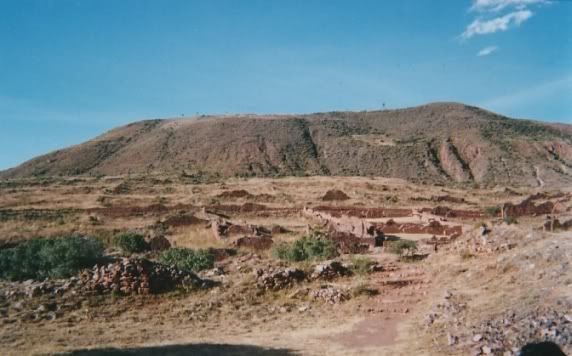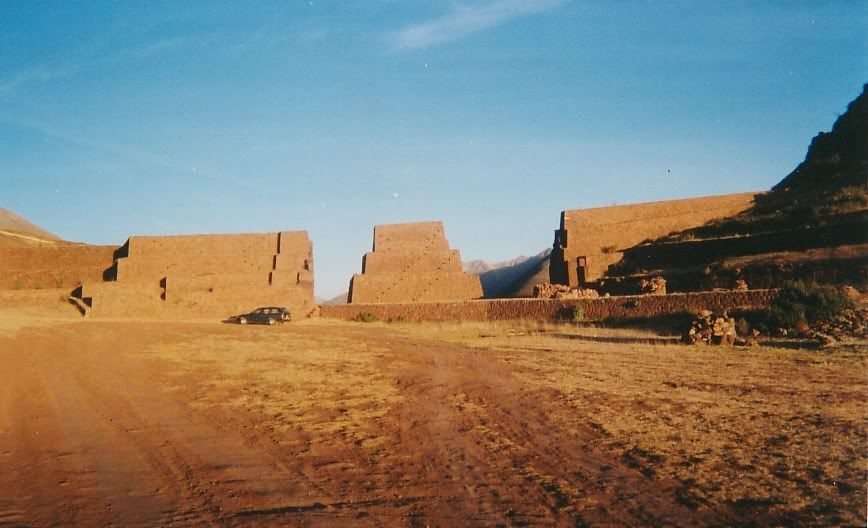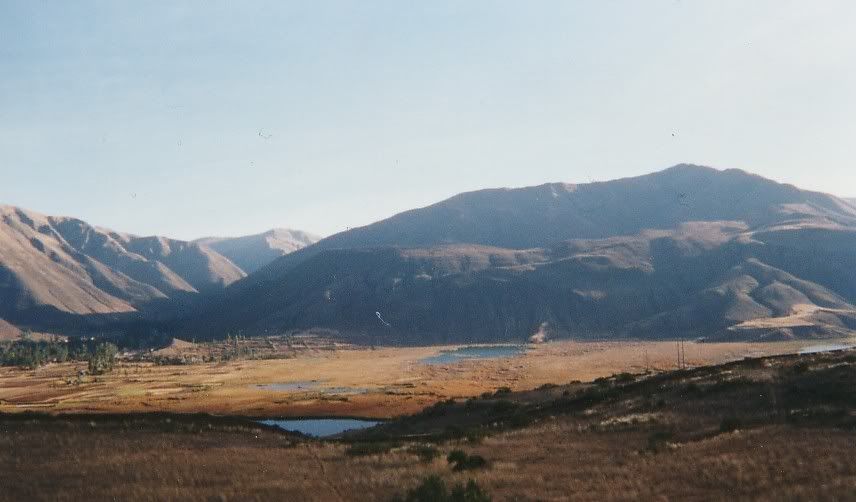![[Home]](/upload/FranzNahrada/logo_dorfwiki_128.jpg)
Uwe Christian Plachetka /
Ciber Puente
Neues
TestSeite
DorfTratsch
Suchen
Teilnehmer
Projekte
GartenPlan
DorfWiki
Bildung+Begegnung
DorfErneuerung
Dörfer
NeueArbeit
VideoBridge
VillageInnovationTalk
AlleOrdner
AlleSeiten
Hilfe
Einstellungen
SeiteÄndern
| The Videobridge – as backbone for information based city decentralization by rural education |
| Meditation exercises on large cities gone into history (Time scale: 1000 C.E. to 1400 C.E.) |
These photos show the results of urban agglomerations that exceeded their regional carriage capacities in sensitive ecosystems.
1000 C.E.: Collapse of the Wari civilization

Fig.1: The two Empires in the Andes that collapsed at the onset of the Medieval Climatic Anomaly -- not only for that reason...
See: SamaipataExpedition
| Impressions from a pre-Inca-city that exceeded it's environmental carriage capacity |

Piquillaqta, the Wari city of Sumaq' T'ika, the princess without water - in the Mohina basin nearby Cusco
- Lake Mohina with still too less water: Paleoclimatological proxy to explain the Incas as precursors of the aldeas globales populares).
 ]
]
- This aquaeduct constructed to supply Piquillaqta didn't help either ...
| Prof Munoz' Report on NICT and rural education in Peru |
| Educational situation in the Rural area in Peru |
As the Peruvian sociologist Liliana HimeldaMuñozVillar? [2] laid clear, (Spanish original published soon) the focus of the last Peruvian administrations (and this concerns the biosphere area of potatoes) gave priority to improvement of life in rural areas nearby the cities such as freshwater supply and effluent systems.
But there is a trend to convert rural areas to urban areas on the paper in order to get rapid access to public services. This urbanization process concerns the "peri-urban" zones around the cities whereas more remote rural zones still do not have access to electricity due to skyrocketing costs of power lines to them.
Anyway, a certain educational level is a must to make people using the Internet [3].
This requires education to get access to educational ressources provided by the New Information and Communication technology, as there are severe obstacles to mobilize mental ressources [4]
| Infrastructural and economic obstacles |
- Infrastructure that is not adequate because it is not constructed by the government (of the modern state) but by traditional forms of colaborative work (minga) - and therefore not designated to get access to the information flow (I think this is not soooooo bad, if the colaborative work is responsible for infrastructure, but it matters WHICH kind of).
- Lack of adequate pedagogic material, with a poor village library containing outdated books
- Educational programs (curricula) which do not match the reality of life
- Teachers are perhaps not quite welcomed
- School desertion by both: the students and the professors
- Premature pregnancy
- Agricultural activities, works that must be done
- Lack of parental economic recourses.
| Ideological obstacles |
- Intercultural incompetence [5] This means that rural colleges tend to present themselves as having the property of valid knowledge, ignoring the local knowledge of the people. So they exclude their students from local knowledge systems.
- Lack of ethnic identity / identification of the teaching staff - that means to the local people they are "extraterrestrials"
- Teachers doing their job in a non-dilligent way as they seek opportunities to get a job in the cities.
| Videobridges - a possible solution? |
Rural development by means of innovative social systems is a strategy that is sometimes sought by the Quechua-speaking peasants themselves as they sometimes know that they are running a Vavilov center - and seek strategies to make money out of this fact. To me this need to "channels" concerning Information Technology:
- A channel to be world-wide present (self-controled webpage, that can easily be actualized, web community etc.)
- A communication strategy to interact with other people, especially to get highly qualified lectures in.
Hernán Fernandez observed that the educational process in Peru and especially in the rural world of Peru is facing the limits drawn by poverty of the rural families and sequels such as poor nourishment of schoolchildren that is a clear obstacle for studying[7] This is affirmed by Amayta Sen who says that poverty is not only due to low household incomes but also due to the privated basic skills.
QUESTION: The economic value of local cultures in terms of wellfare
| The problem of rural analphabetism |
The salary for teachers in Peru doesn't buy the basic articles for survival, so that the rural zones are the most vulnerable zones. In many cases the teachers have to live at their workplaces. In recent years the governmental task of erading analphabetism was not quite sucessfull, as there is a percentage of analphabetism in those rural areas which are considered as the areas of extreme poverty of the land, such as the departments:
- Puno
- Cusco
- Huancavelica
- Ayacucho
- Apurimac
- commerce,
- carpentry,
- masonry,
- weaving
- zapatería (shoe making) , etc.
The temporary migrations or definitorias to intermediate cities, the capital of the country or the foreigner. She is one of the strategies of sobreexperience of the farmers (ace) as opposed to the poverty in which they live[8] .
| Against all odds - to the cyberspace |
Although these problems are not solved, the rural youth has interest to use the cyberspace.
Prof. Munoz says:
In spite of the inequalities within the regions concerning the socioeconomic levels, or the rear areas and especially on the countryside, there is demand for internet services.
Regions of the socioeconomic levels C, D and E, have difficulties to afford the purchase of a PC. Faced with this situation, most of the citizens look for economic alternatives to get online, as they have access to the Internet cabins, with tariffs according to their economic possibilities. The use of the Internet is considered as a far-reaching factor to propell the descentralization of the country, and especially in Peru the Internet is considered as a tool to pull down the walls excluding many people from political participation and socio-economic development. Only the peasants in extreme poverty do not use the internet as they cannot defend their basic rights, especially the right for education. [9]
| Who gets the rural population online? |
The facility of the access of the Internet in the countryside is provided through FITEL (Investment fund in Telecommunications) that pilot in telecommunications promoted by ONG and other communities subsidizes to initiatives of development of projects. Between its primary targets is the masificación of the access to Internet through cabins (telecentros) in all the rural capitals of district of the country, with incidence in the programs of qualification and promotion of the development of local contents [10]
COMMENTARY: According to what is known on really working multicultural societies and programs of local development this local content is a key factor for fighting local depression by moulding local identities and ressource perception.
The government of Toledo impelled the Huascaran Project, the 16 of November of the 2001, whose purpose was: the access to Internet to the schools and schools of the countryside and urban. For it the government cost 22 million dollars to buy 7,000 new computers and soon cost 255 million dollars, being a really important effort for the Peruvian economy. It looked after extending the reach of Internet throughout all Peru, in special improving the quality of the education by means of the use of the TIC (technology, information and communication) in the pedagogical practices. The government has created a Web-page The Educative Vestibule Huascaran, being accessible for students from the country side, of the primary and secondary level, allows the consultation of a virtual library, educative programs of different courses. Not yet all the rural educative centers of the country, have been favored with this program. [11]
TO BE CONTINUED SOON

- [1] Concerning scientific publications and the Dorfwiki I would suggest to get the following text translated: The problems of
 Open_Access in science.
Open_Access in science.
- [2]
 http://www.dorfwiki.org/wiki.cgi?action=browse&id=Portada/LilianaHimeldaMuñozVillar
http://www.dorfwiki.org/wiki.cgi?action=browse&id=Portada/LilianaHimeldaMuñozVillar
- [3] Revista de Educación Volumen XIII Nro 24 .Marzo 2004. Ángela del Valle López Pág.-07
- [4] Original text: La educación rural del país atraviesa por una serie de dificultades como: infraestructuras no adecuadas desatendidas por el Estado en su mayoría fueron construidas por la comunidad, no cuentan con materiales pedagógicos, una biblioteca austera, con libros desactualizados, programas educativos no acorde con nuestra realidad, la falta de vocación de servicio de los profesores, la deserción escolar tanto del profesor(a) como el alumnado, Uno de los obstáculos de los alumn@s de continuar con sus estudios secundarios es el embarazo a temprana edad, las labores agrícolas y ganaderas, como es el sembrio y el cuidado del ganado o la falta de recursos económicos de sus padres
- [5] Original Text: En la mayoría de las escuelas y colegios rurales del país, se han creído poseedoras de todo el saber válido y han excluido de sus confines de a saberes locales. La falta de identidad de los(as) maestros(as) rurales en su mayoría están buscando salir su meta es la ciudad ante el centralismo del país, son muy raras las ocasiones en las que el o la profesora van al campo por su propia voluntad.
- [6] Original Text: Hernán Fernández, en sus ensayos sobre el problema educativo, constata que la educación en el Perú sobre todo en el mundo rural, confronta las limitaciones impuestas por la pobreza de las familias campesinas y la secuela que ésta genera en la salud y nutrición de los niños y jóvenes en edad escolar, condiciones que impiden o dificultan el aprendizaje y a los que habría que señalar como los causantes de la deserción y repitencia. (Fernández,1982,1983,1984) . Esto lo confirma Amartya Sen (2000) y dice que la pobreza no solo es la falta de ingresos sino también la privación de capacidades básicas.
- [7] FORO EDUCATIVO Protagonistas de la educación rural y urbana en el Perú apoyado por “Save the Children U.K”.y de la Fundación Ford, Lima octubre. 1994. Pág.-104.
- [8] Original Text: Ante un sueldo que no compensa sus necesidades básicas de los(las) profesores(as) de nuestro país, siendo las zonas rurales más vulnerables en muchos casos los profesores(as) tienen que residir en el lugar donde enseñan. En años atrás la preocupación de los anteriores gobiernos por disminuir las altas tasas de analfabetismo, no ha sido exitosa porque aun existe un porcentaje de analfabetos(as) en las zonas rurales consideradas en extrema pobreza del país, como: Puno, Cuzco, Huancavelica, Ayacucho y Apurimac. Ante una postergación del agro, la no rentabilidad de la actividad agrícola que conlleva que millones de familias opten por la diversificación de actividades económicas como: comercio, carpintería, albañilería, textileria, zapatería, etc. Las migraciones temporales o definitorias a ciudades intermedias, a la capital del país o al extranjero. Es una de las estrategias de sobrevivencia de los campesinos(as) frente a la pobreza en la que viven.
- [9] Original Text: A pesar de las desigualdades en las regiones referente a los niveles socioeconómicos, del interior del país y en especial en las zonas rurales. Los niveles socioeconómicos C, D y E, tienen dificultades para adquirir la compra de un PC. Ante esta situación, la mayoría de los ciudadanos buscan alternativas más económicas para acceder a Internet, como es el acceso a las cabinas de Internet, con tarifas alcance de los bolsillos. El uso de Internet considerado como un impulso trascendental para la descentralización, en el caso de nuestro país las cabinas de Internet tanto en las zonas urbanas y rurales, es un elemento que permite el acceso al Internet, disminuyendo las brechas de exclusión y desigualdad social frente a los que tienen. A pesar de esto existen porcentajes altos de pobreza rural, familias campesinas que se encuentran en extrema pobreza, no tienen recursos económicos para cubrir sus necesidades básicas, siendo una limitación al derecho a la educación elemental que no les permite el acceso al Internet.
- [10] La facilidad del acceso del Internet en las zonas rurales se da a través de FITEL (Fondo de Inversión en Telecomunicaciones) que subvenciona iniciativas de desarrollo de proyectos piloto en telecomunicaciones promovidas por ONG y otras comunidades. Entre sus objetivos principales se encuentra la masificación del acceso a Internet a través de cabinas (telecentros) en todas las capitales de distrito rurales del país, con incidencia en los programas de capacitación y promoción del desarrollo de contenidos locales.
- [11] El gobierno de Toledo impulsó el Proyecto Huascaran, el 16 de noviembre del 2001, cuya finalidad fue: el acceso a Internet a las escuelas y colegios de las zonas rurales y urbanas. Para ello el gobierno gasto 22 millones de dólares para comprar 7.000 nuevas computadoras y luego se gasto 255 millones de dólares, siendo un esfuerzo realmente importante para la economía peruana. Se busco extender al alcance de Internet por todo el Perú, en especial en las zonas más desfavorecidas, como mejorar la calidad de la educación mediante la utilización de la TIC (tecnología, información y comunicación) en las prácticas pedagógicas. El gobierno ha creado una página Web. El Portal Educativo Huascaran, siendo accesible para los alumn@s del país, del nivel primario y secundario, permite la consulta de una biblioteca virtual, programas educativos de diferentes cursos. Aun no todos los centros educativos rurales del país, han sido favorecidos con este programa.
